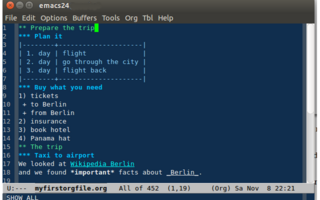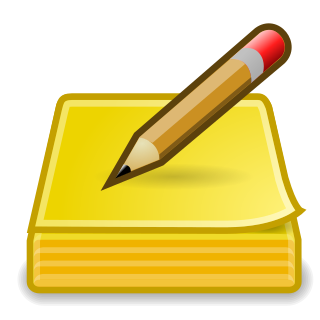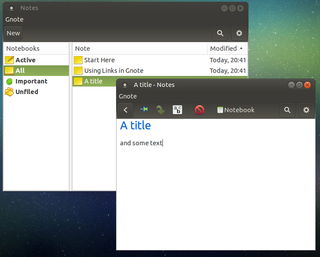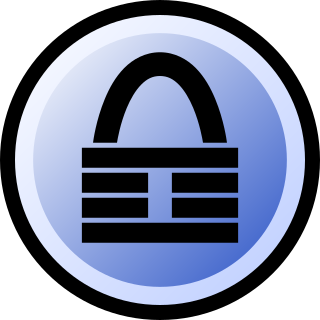Portable Document Format (PDF), standardized as ISO 32000, is a file format developed by Adobe in 1993 to present documents, including text formatting and images, in a manner independent of application software, hardware, and operating systems. Based on the PostScript language, each PDF file encapsulates a complete description of a fixed-layout flat document, including the text, fonts, vector graphics, raster images and other information needed to display it.

rsync is a utility for efficiently transferring and synchronizing files between a computer and an external hard drive and across networked computers by comparing the modification times and sizes of files. It is commonly found on Unix-like operating systems. Rsync is written in C as a single threaded application. The rsync algorithm is a type of delta encoding, and is used for minimizing network usage. Zlib may be used for additional data compression, and SSH or stunnel can be used for security. Rsync is the facility typically used for synchronizing software repositories on mirror sites used by package management systems. It is also one of the fastest ways to delete a large number of files with a binary application, especially when compared to the Linux standard applications rm and find.

An outliner is a specialized type of text editor used to create and edit outlines, which are text files which have a tree structure, for organization. Textual information is contained in discrete sections called "nodes", which are arranged according to their topic–subtopic (parent–child) relationships, sort of like the members of a family tree. When loaded into an outliner, an outline may be collapsed or expanded to display as few or as many levels as desired.

Tomboy is a free and open-source desktop notetaking app written for Windows, macOS, Linux, and BSD operating systems. Tomboy is part of the GNOME desktop environment. As Ubuntu changed over time and its cloud synchronization software Ubuntu One came and went, Tomboy inspired various forks and clones. Its interface is a word processor with a wiki-like linking system to connect notes together. Words in the note body that match existing note titles become hyperlinks automatically, making it simple to construct a personal wiki. For example, repeated references to favorite artists would be automatically highlighted in notes containing their names. As of version 1.6 (2010), it supports text entries and hyperlinks to the World Wide Web, but not graphic image linking or embedding.

Lazarus is a free cross-platform visual integrated development environment (IDE) for rapid application development (RAD) using the Free Pascal compiler. Its goal is to provide an easy-to-use development environment for programmers developing with the Object Pascal language, which is as close as possible to Delphi.

KeyNote is a free notetaking and outlining text editor produced by Tranglos Software for the Windows operating system.
This is an overview of software support for the OpenDocument format, an open document file format for saving and exchanging editable office documents.
This article describes the technical specifications of the OpenDocument office document standard, as developed by the OASIS industry consortium. A variety of organizations developed the standard publicly and make it publicly accessible, meaning it can be implemented by anyone without restriction. The OpenDocument format aims to provide an open alternative to proprietary document formats.

OmegaT is a computer-assisted translation tool written in the Java programming language. It is free software originally developed by Keith Godfrey in 2000, and is currently developed by a team led by Aaron Madlon-Kay.
The following is a comparison of e-book formats used to create and publish e-books.
Zoner Photo Studio is a software application developed by the Czech-founded company Zoner Software. This bitmap editor and image file manager is one of the most widely used programs for editing digital photographs in its country of origin, and is also widely used around the world.
Personal Knowbase is a freeform notes database application for MS Windows. Personal Knowbase was first released in 1998 on the CompuServe Information Service and is an example of a personal knowledge base.

Gnote is a free and open-source desktop note-taking application written for Linux, cloned by Hubert Figuière from Tomboy. It uses a Wiki-like linking system to connect notes together. Gnote is part of the GNOME desktop environment, often filling the need for personal information management. The main principle is a notepad with a wiki-style interface. Words in the note body that match existing note titles automatically become hyperlinks, allowing for the management of large libraries of personal information, such as references to favorite artists that would then automatically be highlighted in notes containing their names. Plugins extend the program to include functionality like exporting to HTML and printing support. As of version 0.8.0, Gnote has been ported to GTK+3.
AllMyNotes Organizer is an outliner application for Windows, and it allows you to store all documents and notes in a single storage file. Documents are organized in a hierarchical tree representation for quick browsing by topic. A portable version which can be installed on a USB flashdrive, iPod, or removable hard disk drive which can be used on any PC without the need to be installed is also available.

KeePass Password Safe is a free and open-source password manager primarily for Windows. It officially supports macOS and Linux operating systems through the use of Mono. Additionally, there are several unofficial ports for Windows Phone, Android, iOS, and BlackBerry devices. KeePass stores usernames, passwords, and other fields, including free-form notes and file attachments, in an encrypted file. This file can be protected by any combination of a master password, a key file, and the current Windows account details. By default, the KeePass database is stored on a local file system.

Zim is a graphical text editor designed to maintain a collection of locally stored wiki-pages, a personal wiki. Each wiki-page can contain things like text with simple formatting, links to other pages, attachments, and images. Additional plugins, such as an equation editor and spell-checker, are also available. The wiki-pages are stored in a folder structure in plain text files with wiki formatting.
Outline is a note-taking application, available on iOS and OS X platforms. It is being developed by Gorillized Corporation, specializing in Productivity and Business apps for Apple devices. The distinguishing features of Outline are design, hierarchy, free placement of notes as in a paper notebook, support of various types of content, synchronization options and Microsoft OneNote compatibility.
WhizFolders is an organizer and outliner for managing notes on MS Windows. WhizFolders has been around since 1998. Its predecessor WhizNote, a plain text notes organizer, was released in CompuServe forums in 1993.

Joplin is a free and open-source desktop and mobile note-taking application written for Unix-like and Microsoft Windows operating systems, as well as iOS, Android, and Linux/Windows terminals, written in JavaScript using Electron. Joplin's workflow and featureset is most often compared to Evernote.








